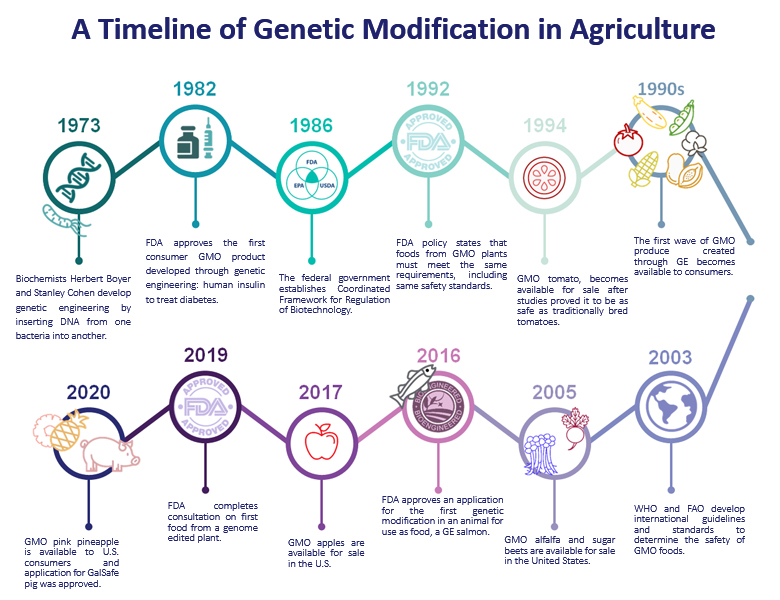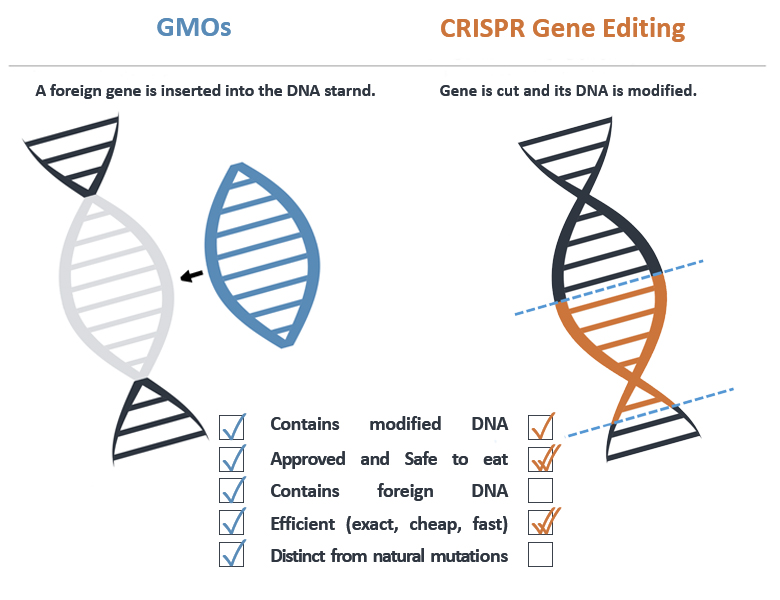The difference between GM and CRISPR-modified products

- | آتاماد |
- Viewer: 261
For thousands of years, humans have used traditional breeding methods such as selective breeding and cross-breeding to breed plants and animals with more desirable traits. However, in recent decades, advances in biotechnology have allowed scientists to directly modify DNA through bioengineering. Modifying organisms in traditional ways is time-consuming and difficult to make very specific changes, often with different results. Whereas, DNA modification using biotechnology allows scientists to change the genetic structure in a targeted and high-speed manner.
GMO or genetically modified organism refers to an animal, plant, or microorganism whose DNA has been changed using genetic engineering techniques. GM foods are as safe as non-GMO foods. According to scientists, genome modification has been done for thousands of years by traditional methods and is not limited to genetic engineering methods, so no government agency such as FDA or USDA approves the non-GMO label.
Organic Products
Organic products have less pesticide residue, but it is unclear whether it contains a higher nutritional value. Organic farms are inspected annually and organic regulations dictate to farmers what kind of pesticides to use. Also, producers should explain the process of soil fertility, and pest management in their fields. For livestock, all pastures and feed must be certified organic, meaning they must contain at least 95% organic ingredients and cannot use banned pesticides or GMOs. Animals should not receive prophylactic antibiotics or additional growth hormones. However, a product that claims to be "organic" may only be 70% organic.

GM or GE Products
Genetically Engineered (GE) and Genetically Modified (GM) are synonyms. The only difference is their application in different geographical areas. In Europe, GE is more common, whereas, in the United States, GM is used. Bioengineered is a new label that has become mandatory at the beginning of 2022. These labels must be displayed on all genetically modified food products. However, products made from animals fed GM feed will not need to be labeled.
Most GM animals are produced for research and some for human consumption. For example, salmon has been genetically engineered to mature a year earlier and is safe to eat according to the US Food and Drug Administration. The first GMO crops were produced and introduced for human consumption in the mid-1990s. Today, almost 90% of corn, soybeans, and sugar beets in the market are GM. GM products have a higher yield, are more durable, resistant to diseases and pests, and even taste better. All of this is a win-win for farmers, consumers, and the environment.
Pesticide resistance is the most important trait of GM crops that have become commercial. BT cotton is a GMO cotton that is genetically altered by the insertion of genes from a common soil bacterium, Bacillus thuringiensis (Bt), to reduce the need for chemical pesticides by about 80%. In fact, these GMO products use the genetics of other organisms to obtain improved traits that they did not have before. For example, golden rice is genetically modified from a narcissus flower and a soil bacterium, which produces beta-carotene, thus reducing the mortality caused by vitamin A deficiency. These products undergo extensive research and testing before they are ready for launch, so the entire process of bringing a GM product to market takes several years.
However, GM foods are still controversial. The changes made by genetic engineering usually do not occur naturally, and in this method, genes from a completely different organism are usually inserted into another organism, which increases the possible risk of allergic reactions. Another concern with these products is the release of foreign DNA into non-GM plants and animals. However, until now none of the approved GMOs have caused any of these problems due to the existence of strict safety regulations. However, probably in the future, GMOs will play an important role in biomedical research, they may contain higher nutritional value and medicinal compounds.
GMOs in Iran
Labeling GM foods is required in 65 countries, including Australia and all EU countries. In the United States, some products containing GMOs must be labeled.
Currently, some of the food products available in the Iran market are GM, but due to the non-enforcement of the labeling law, consumers are not able to recognize these products. Today, only 3 GM products including oilseed rape, soybean, and corn are licensed for consumption in Iran.
Concerns about GM crops used by livestock feed
Some dairy cows may consume GM feed, such as canola meal, but it should be noted that the safety of these products is evaluated by government agencies. There is no scientific evidence that GM feed affects milk composition. Contrary to popular belief, GM feed does not change the genetics of the animal and the composition of its milk. For example, cow's milk contains only dairy proteins and does not contain any corn or wheat proteins.
Genome editing tools and GMOs
Overcoming the limitations of traditional genome editing methods in improving the quality of products depends on the use of new genome editing tools such as CRISPR/Cas9, ZFN, and TALEN, which can make faster and more precise changes in the genome.
CRISPR/Cas9 is the most common and well-known genome editing technique that has been applied today to many types of plants and animals, some of which are already commercially available. The science behind CRISPR is complex, but in a nutshell, it involves cutting DNA strands with molecular scissors.

CRISPR or GMO?
As for GM crops, conflicting information and views on safety aspects persist due to concerns about the introduction of foreign DNA fragments, and the transfer of antibiotic resistance genes. Therefore, the need to use advanced genome editing methods to improve the quality and effective performance of crops, in parallel with the elimination of biosafety doubts, environmental concerns, and the acceptability of human societies, is felt more and more.
On the other hand, CRISPR/Cas9 technology is capable of creating targeted mutations and deletions in inaccessible genes with high heritability and stability without transferring foreign genes. It is also nearly impossible to detect CRISPR-modified DNA, and such changes are indistinguishable from naturally occurring mutations.
The law for labeling these products is different in the United States and Europe. According to the United States policy, which is product-based, until CRISPR does not insert foreign parts into the genome of a living organism, the resulting product is not considered GM, and on this basis, scientists call such products as natural products, not GM. Also, these products are more accepted by the general public than GM products carrying foreign DNA, not considering GMOs by FDA.
The rules in the European Union, however, are slightly different, and due to process-based rules, the term (GMO) is defined based on the process followed. In fact, the production process of the product will determine its ability to be introduced in the market. Therefore, in some countries of the European Union, any product produced by GE methods must be labeled as GMO.
Furthermore, due to the strict and very expensive regulatory process, only wealthy private sector companies can participate in the commercialization of GM products. But on the other hand, regulatory frameworks governing GE are less restrictive than GMO regulations, and moving toward commercialization is easier.
All in all, using environmentally friendly GE technologies to increase production efficiency and provide food security for the growing world population, especially developing countries, is of great importance. On the other hand, genome editing technology simply accelerates natural selection, an approach that has been used for centuries to improve the quality of crops. Also, consumer education is key to the full adoption of this technology. Gene editing assures the consumer that GE products are safe and improved.
References:
https://education.nationalgeographic.org/resource/genetically-modified-organisms/
https://www.fda.gov/food/agricultural-biotechnology/science-and-history-gmos-and-other-food-modification-processes
https://www.newhope.com/business-resources/future-food-preserving-biodiversity-navigating-climate-change
https://global.wf.com/hub_article/genetically-modified-vs-gene-editing/
GET IN TOUCH
Copyright © 2023 Atamad.com All right reserved
Website design and SEO services by Seohama team – Web hosting by Sarverhama
Copyright © 2023 Atamad.com All right reserved
Website design and SEO services by Seohama team – Web hosting by Sarverhama








